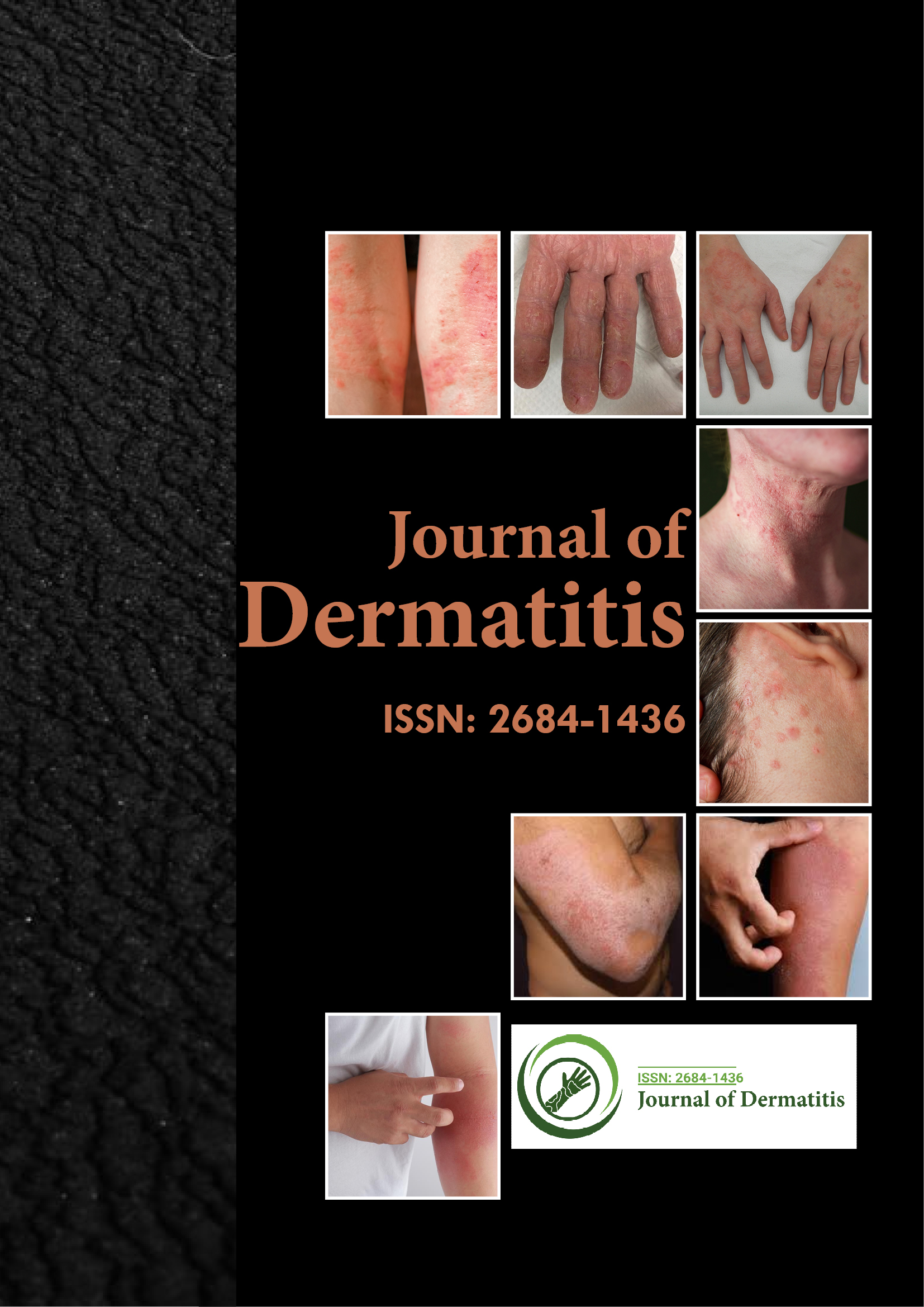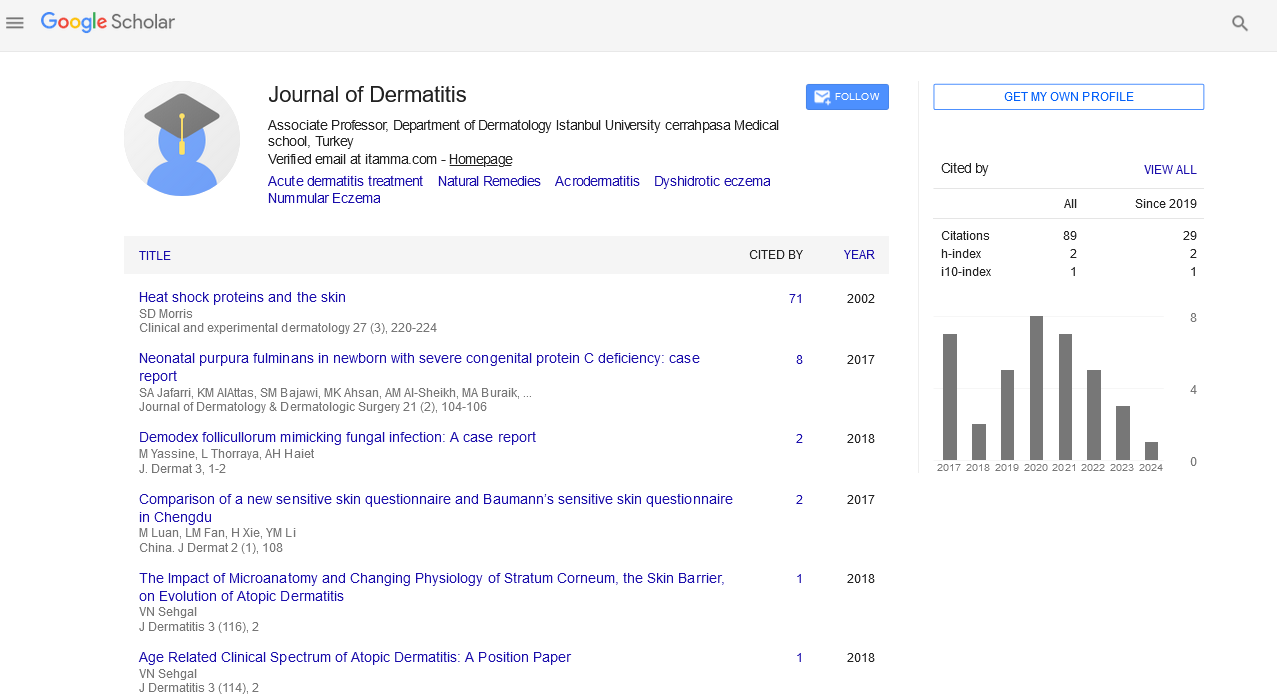Indexed In
- RefSeek
- Hamdard University
- EBSCO A-Z
- Euro Pub
- Google Scholar
Useful Links
Share This Page
Journal Flyer

Open Access Journals
- Agri and Aquaculture
- Biochemistry
- Bioinformatics & Systems Biology
- Business & Management
- Chemistry
- Clinical Sciences
- Engineering
- Food & Nutrition
- General Science
- Genetics & Molecular Biology
- Immunology & Microbiology
- Medical Sciences
- Neuroscience & Psychology
- Nursing & Health Care
- Pharmaceutical Sciences
Opinion Article - (2024) Volume 9, Issue 3
Impact of Diisononyl Phthalate on Langerhans Cells in Allergic Contact Dermatitis
Anna Müller*Received: 30-Aug-2024, Manuscript No. JOD-24-27946; Editor assigned: 02-Sep-2024, Pre QC No. JOD-24-27946 (PQ); Reviewed: 16-Sep-2024, QC No. JOD-24-27946; Revised: 23-Sep-2024, Manuscript No. JOD-24-27946 (R); Published: 30-Sep-2024, DOI: 10.35248/2684-1436.24.9.244
Description
Allergic Contact Dermatitis (ACD) is a common inflammatory skin condition that results from the immune system’s hypersensitive reaction to certain allergens. One of the main cell types involved in the initiation and progression of ACD are Langerhans Cells (LCs), which are specialized dendritic cells found in the epidermis. These cells play an essential role in immune surveillance, capturing and processing allergens before presenting them to T cells, initiating the allergic response. While much is understood about the general functions of Langerhans cells in ACD, their involvement in specific scenarios, such as Diisononyl Phthalate (DINP)-aggravated allergic contact dermatitis, is an area that warrants further exploration. The potential for phthalates, including DINP, to exacerbate skin conditions, particularly in those already predisposed to dermatitis, highlights the need to investigate how environmental pollutants may interact with immune cell functions and skin health.
Diisononyl phthalate, a common plasticizer used in a wide range of industrial and consumer products, has been shown to possess endocrine-disrupting properties and is associated with allergic responses. As a widely used chemical, DINP is commonly found in daily life, contributing to environmental exposure that may play a role in the pathogenesis of allergic diseases. Although DINP is primarily known for its toxicological effects, recent studies suggest that it can exacerbate allergic reactions by improving inflammatory responses, especially in conditions such as allergic contact dermatitis. The effect of DINP on Langerhans cells in ACD remains a critical area of investigation, as LCs are important factors in the skin's immune system and are directly involved in the initial allergic response to environmental allergens.
Langerhans cells function as the first line of defense against pathogens and allergens. Upon encountering an antigen, these cells undergo a process known as antigen presentation, where they capture, process and reduce to lymph nodes to activate T cells. This activation of the adaptive immune system ultimately results in the clinical manifestations of ACD, including erythema, swelling and itching. In the context of DINP exposure, research suggests that LCs may become hyperactivated or undergo alterations in their function, potentially contributing to an aggravated allergic response. The exact mechanisms through which DINP affects LCs are not yet fully understood, but there are a few critical pathways that are likely involved.
One possible mechanism is the alteration of the skin’s immune tolerance. Langerhans cells play an essential role in maintaining immune homeostasis, ensuring that harmless environmental substances do not activate an inappropriate immune response. In the case of DINP exposure, these cells may become more responsive to allergens, improving the ability of the immune system to react against substances that would otherwise be considered harmless. This heightened sensitivity can lead to an exaggerated immune response upon subsequent allergen exposure, aggravating the symptoms of allergic contact dermatitis.
Additionally, it is known that Langerhans cells communicate with other immune cells, including T-helper cells, through cytokine production. In the presence of DINP, the activation of LCs could potentially lead to an increased release of proinflammatory cytokines, such as IL-1, IL-6 and TNF-α. These cytokines act as signals to recruit more immune cells to the site of inflammation, creating a feedback loop that reduces the inflammatory response. The result is an escalation of the symptoms of ACD, which may present as more severe rashes, blisters, or even systemic involvement in some cases.
One potential direction for future research involves investigating whether targeting the Langerhans cell response can minimize the effects of DINP exposure on allergic contact dermatitis. Therapeutic approaches that modulate the activity of LCs, such as through the use of immune-modulating drugs or topical treatments, could hold potential in preventing or reducing the symptoms of phthalate-induced dermatitis. For example, factors that can block the cytokine signaling pathways activated by LCs or reduce the recruitment of additional inflammatory cells may prove effective in controlling DINP-aggravated ACD.
In conclusion, Langerhans cells play a major role in the immune response to allergens and their function is likely modified by environmental pollutants like diisononyl phthalate. The exacerbation of allergic contact dermatitis due to DINP exposure highlights the importance of understanding how these immune cells respond to environmental insults. By further investigating the interaction between DINP and Langerhans cells, we can gain a deeper understanding of the molecular mechanisms behind aggravated allergic reactions and develop more targeted therapies for managing ACD. Given the extensive exposure to phthalates and the increasing prevalence of allergic diseases, this research could have significant implications for public health and clinical treatment strategies.
Citation: Müller A (2024). Impact of Diisononyl Phthalate on Langerhans Cells in Allergic Contact Dermatitis. J Dermatitis. 9:244.
Copyright: © 2024 Müller A. This is an open access article distributed under the terms of the Creative Commons Attribution License, which permits unrestricted use, distribution, and reproduction in any medium, provided the original author and source are credited.

